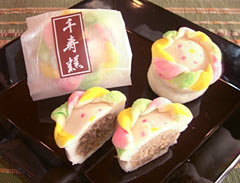Senjuko – confectionary of the Ryukyu Dynasty is restored

Ryukyuan traditional sweets called senjuko that have been reproduced after a gap of 30 years.
October 5, 2011 Ryukyu Shimpo
For the first time in three decades, Ryukyuan traditional sweets called senjuko have been recreated and sold by the Chinsuko Hompo Arakaki Kashiten (a confectionery company) that has its head office in Shuri, Naha City. The thing that brought this about was Tempest, a novel set in the Ryukyu Dynasty. The company has been in business for 72 years, and can trace its know-how back to a chef in the Ryukyu Dynasty. The confectionary has been handcrafted from this February using traditional manufacturing methods.

Satoshi Adaniya, factory director (right) and Yoshitoyo Arakaki, executive managing director of the company making senjuko, at the factory in Nanjo City.
Executive managing director 36 year-old Yoshitoyo Arakaki explained, “Senjuko was prepared for Buddhist memorial services and celebrations, and was made often until around the reversion of Okinawa to Japanese sovereignty. However, the reversion meant that Japanese and Western confectionery prevailed, and traditional sweets with a complex manufacturing process disappeared.”
Factory manager 54 year-old Satoshi Adaniya, who has 37 years experience in this business behind him, learned the manufacturing method directly from the last chef, but he had a tough time remembering the details of the process. “Shaping the petals is difficult. I always ask myself am I doing it the right way, as I make them,” he said.
Senjuko is available only from four stores run by the company, and because it is made by hand, its production is limited to between 50 and 100 units a day.
During the Ryukyu Dynasty, Ryukyuan traditional sweets developed independently, with influence from both China and Japan. Although the names of over 200 sweets appear in literature, almost all of the recipes were lost with the overthrow of the dynasty and the awful damage to all manner of Okinawa’s cultural assets during World War II.
(English Translation by T&CT, Lima Tokumori and Mark Ealey)
Previous Article:New Zealand researchers working on the English translation of Senka o Horu for publication in the United States
Next Article:Relocating U.S. Marines outside of Okinawa entails no significant loss of operational effectiveness
[Similar Articles]
- Tour at Nakamura House Recreates Hospitality of Ryukyu Royal Family Gourmet
- Sweet Bakery Porsche wins top award in All Japan Great Pastry Fair 2013
- Okinawan sanshin to be designated as heritage craft
- Ryukyu dynasty-style added to list of Okinawa resort weddings
- Tougazuke sweet awarded top prize at 36th Naha Food and Product Fair
 Webcam(Kokusai Street)
Webcam(Kokusai Street)


